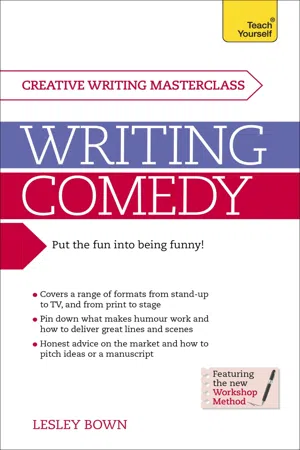
Writing Comedy
How to use funny plots and characters, wordplay and humour in your creative writing
Lesley Bown, Lesley Hudswell
- 256 páginas
- English
- ePUB (apto para móviles)
- Disponible en iOS y Android
Writing Comedy
How to use funny plots and characters, wordplay and humour in your creative writing
Lesley Bown, Lesley Hudswell
Información del libro
Learn how to write comedy that makes people laugh. Masterclass: Writing Comedy will reveal to both beginners and experienced writers the distinctive features that mark out comedy from other forms of creative writing. Having identified these, it will help you then to unlock your inner anarchist, and explore the different elements of comedy, using a combination of practical exercises, insight and creative inspiration. Whatever your preferred comic genre, you will find guidance on everything from wordplay and visual humour to plots, comedy characters and different styles.A section on performance will help you to hone stand-up skills, while chapters on stage and screen will give techniques and tips on how to craft a sitcom or create a sketch show. Finally, there is a uniquely frank but useful section on the realities of the markets, and the actualities of going it alone with self-publishing and self-promotion - or the tools you need to successfully pitch an idea or comic manuscript.ABOUT THE SERIES
The Teach Yourself Creative Writing series helps aspiring authors tell their stories. Covering a range of genres from science fiction and romantic novels to illustrated children's books and comedy, this series is packed with advice, exercises, and tips for unlocking creativity and improving your writing. And because we know how daunting the blank page can be, we set up the Just Write online community, at tyjustwrite.com, for budding authors and successful writers to connect and share.
Preguntas frecuentes
Información


 | Alan Ayckbourn, director and playwright |

 | Key idea |

 | Create surprise |

 | Focus point |

 | Create incongruity |

 | What do you find funny? |

 | The more boring the better… |

Índice
- Cover
- Title
- Dedication
- Acknowledgments
- Contents
- Meet the author
- Introduction
- 1 Comedy basics
- 2 The comedy writing mindset
- 3 Getting started
- 4 Language and style
- 5 Jokes
- 6 Stand-up
- 7 Simple characters and situations
- 8 Quickies and sketches
- 9 Creating more complex characters
- 10 More complex situations and plots
- 11 Sitcoms
- 12 Character development and deeper plotting
- 13 Editing, polishing and unblocking
- 14 Writing for different media
- 15 The practicalities of placing your work
- Appendix A: Other types of comedy writing
- Appendix B: Comedy styles and genres
- Appendix C: Doing it yourself
- Appendix D: Figures of speech
- Appendix E: Works mentioned
- Appendix F: Full texts of examples
- Appendix G: Taking it further
- Copyright